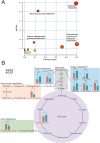Integrated metabolomics and metagenomics reveal plant-microbe interactions driving aroma differentiation in flue-cured tobacco leaves
- PMID: 40530272
- PMCID: PMC12170567
- DOI: 10.3389/fpls.2025.1588888
Integrated metabolomics and metagenomics reveal plant-microbe interactions driving aroma differentiation in flue-cured tobacco leaves
Abstract
Current research on tobacco aroma predominantly focuses on single-omics approaches. In this study, we conducted a comprehensive investigation of the relationships between tobacco metabolite profiles, microbial communities, and aroma characteristics. Untargeted metabolomics and metagenomic analyses were performed on flue-cured upper tobacco leaves to compare light aromatic tobacco (LAT) and strong aromatic tobacco (SAT). The results showed that sugar metabolite levels in LAT were significantly higher than those in SAT, whereas levels of specific acids and amino acid metabolites in SAT exceeded those in LAT. Redundancy analysis (RDA) and metabolomic correlation analyses indicated that the genera Methylorubrum and Pseudomonas may promote sugar metabolite accumulation, while Pseudokineococcus potentially regulates both sugar and acid metabolites. In contrast, Methylobacterium and Sphingomonas were associated with acid and amino acid metabolism, with Methylobacterium additionally exhibiting inhibitory effects on sugar metabolism. Metagenomic analysis revealed that Methylorubrum, Pseudomonas, and Pseudokineococcus were abundant in LAT, whereas Methylobacterium and Sphingomonas dominated in SAT. Notably, the bidirectional regulation of aromatic metabolites by microbial genera such as Pseudokineococcus highlights the universality of plant-microbe interactions in shaping metabolic networks-a mechanism potentially applicable to other crop systems. These findings reveal conserved microbial functional traits (e.g., metabolic pathway modulation) that may drive plant phenotypic differentiation beyond tobacco, offering insights into microbiome-mediated crop quality improvement. The results provide theoretical guidance for tobacco aging and aroma regulation and underscore the broader significance of microbial community engineering in agriculture for manipulating plant metabolic outputs.
Keywords: aroma; flue-cured tobacco; metagenomics; plant-microbe interaction; untargeted metabolomics.
Copyright © 2025 Jia, Wang, Lin, Liang, Dai, Wu, Yang, Zhang and Li.
Conflict of interest statement
The authors declare that the research was conducted in the absence of any commercial or financial relationships that could be construed as a potential conflict of interest.
Figures




Similar articles
-
Integrating Gut Microbiome and Metabolomics with Magnetic Resonance Enterography to Advance Bowel Damage Prediction in Crohn's Disease.J Inflamm Res. 2025 Jun 11;18:7631-7649. doi: 10.2147/JIR.S524671. eCollection 2025. J Inflamm Res. 2025. PMID: 40535353 Free PMC article.
-
Effects of different selenium fertilizer types and dosages on non-volatile organic acids and aroma substances of flue-cured tobacco.Front Plant Sci. 2025 Aug 22;16:1659004. doi: 10.3389/fpls.2025.1659004. eCollection 2025. Front Plant Sci. 2025. PMID: 40918963 Free PMC article.
-
Microbial fertilizers modulate tobacco growth and development through reshaping soil microbiome and metabolome.Microbiol Spectr. 2025 Jul;13(7):e0260524. doi: 10.1128/spectrum.02605-24. Epub 2025 May 22. Microbiol Spectr. 2025. PMID: 40401958 Free PMC article.
-
Changes in microbial composition during flue-cured tobacco aging and their effects on chemical composition: a review.Bioresour Bioprocess. 2025 May 21;12(1):43. doi: 10.1186/s40643-025-00883-8. Bioresour Bioprocess. 2025. PMID: 40397057 Free PMC article. Review.
-
Defining disease severity in atopic dermatitis and psoriasis for the application to biomarker research: an interdisciplinary perspective.Br J Dermatol. 2024 Jun 20;191(1):14-23. doi: 10.1093/bjd/ljae080. Br J Dermatol. 2024. PMID: 38419411 Free PMC article. Review.
References
LinkOut - more resources
Full Text Sources
Research Materials

